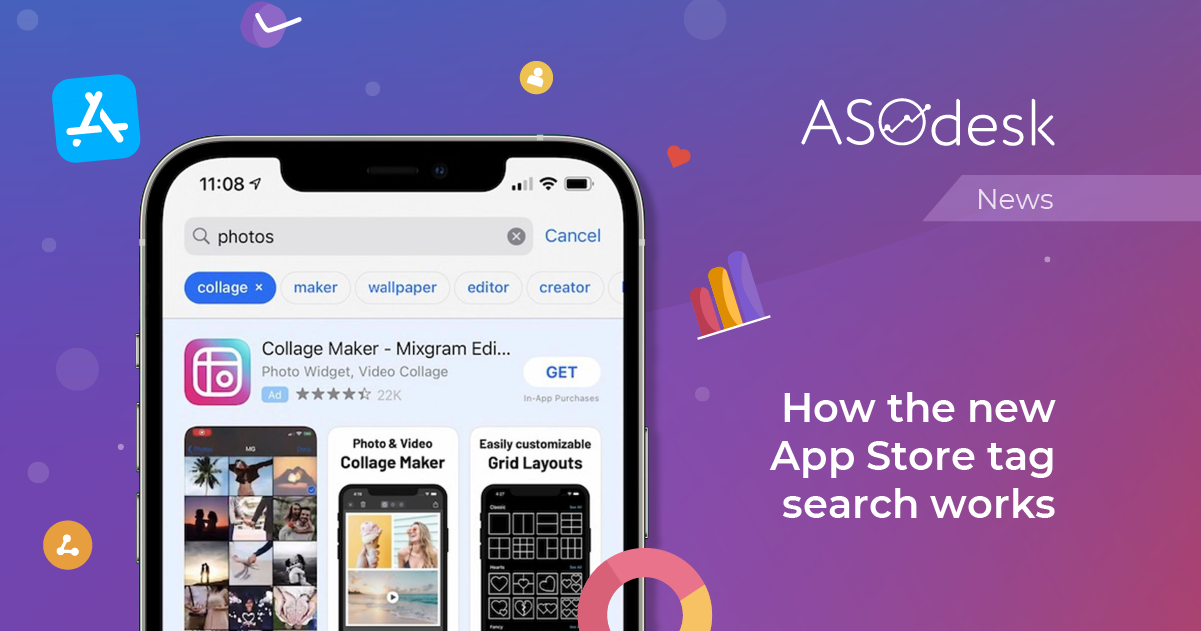How the new tag search works in the App Store

On April 29, Apple officially announced the tag search feature, which is now available to all users in the US, Canada, the United Kingdom, and Australia. We are going to analyze how this feature will function and affect the work of ASO specialists.

The feature is currently available for some iOS 14.5 and iOS 14.4.2 users. Apple is gradually rolling out the update, so not all users see it yet. Tag search testing began back in February, and on April 29 the feature was officially released.
Search suggestions come up after the user types in a query. For example, if you search for “food”, you will see search suggestions such as “delivery”, “games”, and “recipes”. After clicking on one of the search suggestions, the search results will change.
The tag search is a constructor that adds a query to a tag. Words can be added in any order, and the tag can appear in the middle or at the end of the query. For example, for the query “food”, the tag “delivery” comes up. In this case, the tag comes at the end of the phrase after the keyword, and we will get the query “food delivery”. But for the query “games” and the tag “puzzle” we will see the search results for the query “puzzle games”.
Traffic is distributed between popular search queries that have search suggestions and new queries that didn’t get any traffic before. Users will now begin to search for applications more often by selecting the suggested tags.
We asked the experts for their opinion on how these changes will affect the ASO process and the ASO specialists’ work.

Thomas Petit, a world-renowned mobile marketing thought leader and independent app growth consultant

Tags will make the very short tail a bit broader. And of course, that might help ASA. I would assume the inventory (search volume available) will shift a bit, with less TTR on keywords with suggestions, and more impressions on keywords suggested. So monitor your keyword, delivery & TTR carefully.
Tags will also help users refine broad intent queries into something more specific. So eventually, it’s good for everyone, except if you are ranking #1 in the App Store for extreme short tail keywords with lots of traffic.

Artiom Tkachuk, ASO Expert at ASOdesk

We will see a rise in popularity for low-frequency long-tail keywords as small as two words. ASO specialists will also use them more often when optimizing.

Anna Shopina, ASO Manager at Mail.ru Group

Tag search will give you new opportunities to drive organic traffic. It is important to collect the suggested tags as soon as possible, add them to the semantic core, check their popularity, and add queries with the highest volume of traffic to the metadata in order to stay ahead of the competition. This way, you will use the App Store update to your advantage, appearing in the search results for the maximum number of popular tags.

Maria Chernoplyokova, ASO Specialist at Mail.ru Group

It seems that tags are not keywords in the application metadata, but act more like a filter — the mechanism of which is not yet clear.
We can use them in the same way that we use suggestions: find search queries and individual keywords and roughly estimate the traffic of a search query. The higher the suggestion and the closer the tag, the more traffic will come for the request we have generated.
We could see that the traffic for search queries of 2–3 words will increase, while the traffic on queries longer than 3 words will decrease. At the same time, the traffic for many unpopular queries could increase because users will “enter” them using tags. Therefore, when conducting textual optimization, you need to study the tags and take them into account.
It is likely that there will soon be dramatic changes in the incoming search traffic. For some, these changes will be for the better, while others will see changes for the worse.

Anna Antsiferova, ASO Specialist at DevGame

I think people will actively be using this query constructor. As long as it’s not clear how tags will affect the popularity of keywords, there could be two outcomes.
If popularity depends on tags, then due to the collection of long queries by this constructor, our low-frequency queries may soon have a medium frequency. Based on this outcome, ASO specialists will have to expand their core and consider keywords with zero traffic. It is possible that because of these tags, these types of queries might grow.
On the other hand, even more keywords might be left without traffic now. When we select a tag, the query in the search bar does not change. So, it is likely that the traffic can only go towards what is in the search bar.
Now users just need to enter “games” and use tags to add everything they need. In this case, ASO specialists will have to focus more on high-frequency queries such as “games”, “kids”, etc.
So far, the new tag search raises a lot of questions. Perhaps it will help increase the popularity of long-tail keywords longer than two words. So, ASO specialists would need to monitor them more closely now.










